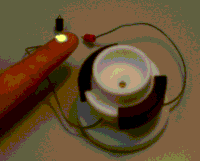New biosensor could save lives by giving faster medical analysis

The biosensor <br>© EPSRC
Every day accident and emergency units have to treat patients who have taken some sort of drug overdose. To give treatment doctors need to know what the patient has taken. The circumstances can make often this difficult to ascertain quickly.
Researchers are developing a new kind of biosensor, which can determine in minutes if a patient’s blood contains a particular compound, for example paracetamol. Currently this type of examination needs to be carried out in a laboratory, which is expensive and time consuming.
The research is being carried out by Dr Sub Reddy’s team at the University of Surrey with funding from the Swindon based Engineering and Physical Sciences Research Council.
The sensor system can return a response in less than 10 minutes compared to the 2 – 3 hours required by a routine laboratory, depending on their workload. “Our sensor is portable and will be easy to use even by unskilled staff,” says Dr. Reddy. “Ideally, the overdose sensor may be located in the ambulance so that a result is available when the patient arrives at hospital.” The paracetamol sensor is the pilot to the development of an array of overdose sensors, which will test for alcohol and anti-depressants as well.
The capabilities of the biosensor extend far beyond helping patients who have taken a drug overdose. “We have successfully used the system to detect glucose,” says Dr Reddy. The team is also investigating the detection of creatinine, a product in the body, which is an indicator of kidney dysfunction.
The heart of the biosensor consists of a disc-shaped quartz crystal, around a centimetre in diameter and 0.2 mm thick. “When an alternating electric field is applied the crystal vibrates from side to side, like a nano-scale earthquake,” says Dr Reddy. “It shakes ten million times a second with an amplitude of a fraction of a nanometre.” The crystal can continue to oscillate even when immersed in a liquid. Anything which then sticks to the crystal surface or which affects the viscosity or elasticity of any attached film at the surface will affect the frequency at which the crystal vibrates.
The concept of the sensor is to have a small reaction chamber above the surface of the crystal. When a sample – blood, say – is placed in the chamber a series of carefully designed chemical reactions can be made to occur which result in the molecule of interest – for example cholesterol – contributing to the formation of a solid product. The product then attaches to the surface of the crystal, affecting the frequency of its oscillation.
Because the chemical reaction can be made to be highly specific to the molecule of interest so that only one solid product is formed, other substances in the sample will not interfere with the process or provide spurious readings.
Dr. Reddy explained how the biosensor has been used to detect glucose. “Here you add the sample to the reaction mixture. An enzyme oxidises the glucose to form hydrogen peroxide. This in turn is acted upon by a second enzyme and reacts with other ingredients in the mixture to form a water repelling molecule, which comes out of solution and can be made to attach to the quartz. This causes a change in the oscillation frequency which can be correlated with the quantity of product, which can in turn be related to the amount of glucose originally present in the sample.”
Dr Reddy believes that his team has demonstrated the feasibility of the concept of using a quartz crystal sensor in this way. “We have shown that the system has excellent sensitivity. We are getting extremely large signals.”
The researchers are now looking into ways of refining the system, by using membranes above the surface, which are selective for specific types of molecule, for example. This would ‘filter out’ any potentially contaminating species to provide a much cleaner and unambiguous reading. “We are building up a portfolio of detection strategies for compounds of interest and we are now reaching the stage where we are looking for industrial collaborators. We are also applying this viscoelastic sensor to lab-on-a-chip type technologies, as well as integrating it with synthetic polymer films capable of molecular recognition,” says Dr Reddy.
Media Contact
All latest news from the category: Health and Medicine
This subject area encompasses research and studies in the field of human medicine.
Among the wide-ranging list of topics covered here are anesthesiology, anatomy, surgery, human genetics, hygiene and environmental medicine, internal medicine, neurology, pharmacology, physiology, urology and dental medicine.
Newest articles

Redefining Cancer Science: Rodents, Humans, and the PD-1 Puzzle
Results of a comprehensive analysis refute assumptions that a key immune checkpoint receptor functions the same in rodents and humans The Discovery of PD-1: A Milestone in Cancer Treatment Since…

Heart Surgery Risks: Low BP Linked to Postoperative Kidney Injury
First large cohort study at the Heart and Diabetes Center NRW awarded – Hilke Jung presents research project at the FoRUM conference of the Ruhr University Bochum A working group…

Microbial Secrets: Boost Plant Growth with the Power of Soil Bacteria
To stay healthy, plants balance the energy they put into growing with the amount they use to defend against harmful bacteria. The mechanisms behind this equilibrium have largely remained mysterious….



